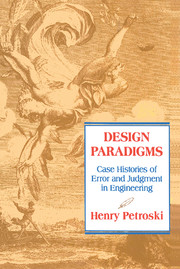Book contents
- Frontmatter
- Contents
- Preface
- 1 Introduction
- 2 Paconius and the Pedestal for Apollo
- 3 Vitruvius's Auger and Galileo's Bones: Paradigms of Limits to Size in Design
- 4 Galileo and the Marble Column
- 5 Galileo's Confirmation of a False Hypothesis
- 6 The Design and Collapse of the Dee Bridge
- 7 The Britannia Tubular Bridge
- 8 Failure as a Source of Engineering Judgment
- 9 The Design Climate for the Tacoma Narrows Bridge
- 10 Historic Bridge Failures and Caveats for Future Designs
- 11 Conclusion
- Bibliography
- Index
- Frontmatter
- Contents
- Preface
- 1 Introduction
- 2 Paconius and the Pedestal for Apollo
- 3 Vitruvius's Auger and Galileo's Bones: Paradigms of Limits to Size in Design
- 4 Galileo and the Marble Column
- 5 Galileo's Confirmation of a False Hypothesis
- 6 The Design and Collapse of the Dee Bridge
- 7 The Britannia Tubular Bridge
- 8 Failure as a Source of Engineering Judgment
- 9 The Design Climate for the Tacoma Narrows Bridge
- 10 Historic Bridge Failures and Caveats for Future Designs
- 11 Conclusion
- Bibliography
- Index
Summary
The concept of failure is central to the design process, and it is by thinking in terms of obviating failure that successful designs are achieved. It has long been practically a truism among practicing engineers and designers that we learn much more from failures than from successes. Indeed, the history of engineering is full of examples of dramatic failures that were once considered confident extrapolations of successful designs; it was the failures that ultimately revealed the latent flaws in design logic that were initially masked by large factors of safety and a design conservatism that became relaxed with time.
Design studies that concentrate only on how successful designs are produced can thus miss some fundamental aspects of the design process, which is difficult enough to articulate as it is. Yet while practicing designers especially are notorious for saying little, if not for consciously avoiding any discussion at all of their own methodology, there have been some notable exceptions (especially, e.g., Glegg, 1973, 1981; Leonhardt, 1984), and when these engineers have reflected on the design process, they have acknowledged the important role that failure plays in it. Although often an implicit and tacit part of the methodology of design, failure considerations and proactive failure analysis are essential for achieving success. And it is precisely when such considerations and analyses are incorrect or incomplete that design errors are introduced and actual failures occur.
- Type
- Chapter
- Information
- Design ParadigmsCase Histories of Error and Judgment in Engineering, pp. 1 - 14Publisher: Cambridge University PressPrint publication year: 1994



